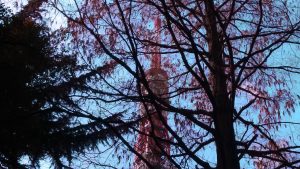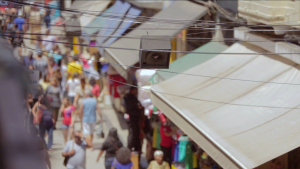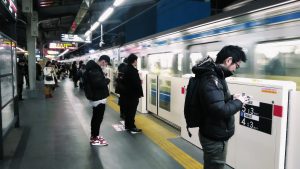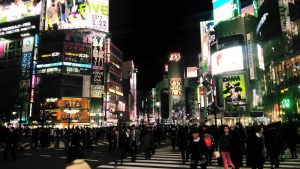
Thinking how to address this month’s topic about sound installations, it occurred to me to write about a subject that is often neglected: the place that reproduced sounds has in the contemporary urban soundscape. Sounds generated by PA systems, sound alerts, radio, television, cellphones… These are all sounds that aren’t necessarily produced at the place where they’re being emitted, but that inhabit this environment nevertheless. Most field recordists tend to think of these sounds as mere interferences for the sounds they really want to record.
For instance, if I’m in a bar recording some nice drunk walla and someone decides to turn on the jukebox filling the air with loud music, I might as well pick up my things and go home or simply drink a cold beer in absolute despair. Either way, I know that all my field recording plans for that place have failed the moment the music starts. Besides that, reproduced sounds don’t have a historically good reputation as well. Canadian composer and researcher Murray Schafer has classified such sounds as schizophonic as a way to address the split between the original sound and its electroacoustic reproduction. Such a strong term was coined by Schafer to reinforce these sounds as noxious, true aberrations. For Schafer, reproduced sounds are like barbarians invading the urban soundscape and implementing a form of sonic imperialism, the victory of massification over diversity and, more importantly, the victory of noise over sounds that actually signify something. I beg to disagree with this. Reproduced sounds aren’t just pure noise, but they carry a lot of meaning with themselves. They can inform us immensely about the places where they’re being emitted. Their form and modes of occurrence are really diverse as well as I intend to show here by comparing such phenomenon in two very different cities: Rio de Janeiro, my hometown, and Tokyo, to where I travelled for the first time a few months ago as a tourist.
Rio’s soundmark
Rio de Janeiro is a city with a strong imagery of itself like very few others in the world: the Sugar Loaf, the Corcovado, the sandy beaches of Copacabana are some of its landmarks recognized abroad. But if we asked ourselves about what would be the city’s soundmarks? A foreigner might think of a slow tempo bossa nova or the gentle sound of birds in a city blessed by nature or, for a more contemporary approach, the sound of gunshots and violence. As a born and raised Carioca, if I had to choose one soundmark for the city, it would be none of these, but simply the roaring, rattling, sizzling sound of Rio de Janeiro’s buses that can be heard all over town. Contrary to most big cities in the world, where the subway is the main mean of transportation and buses are only an ancillary service, Rio still relies heavily on them. And buses from Rio are not of the ordinary kind. Most vehicles here are built with the engine at the front, which makes them much noisier, and have a very poor suspension system. As a passenger, you could be in for a real thrill as you can hear bellow:
This is what happens most frequently in Rio: you would be looking at the idyllic beauty of the Sugar Loaf at Guanabara Bay and still hear the roaring of traffic just behind you as a constant reminder of the intense life of the city. The boundaries between the different spaces (commercial streets, public squares, the beach…), that should supposedly sound very different from one another, are constantly defied by this omnipresent mantra. What you see is not what you get or hear. And cariocas are very much used to this condition. As a Brazilian pop song says, Rio is the purgatory of beauty and chaos: a city full of contrasts not necessarily perceived as such by its inhabitants, a place where conflicts are more prone to be felt than articulated on a conscious level. The density of the soundscape contributes to this general feeling.
The soundscape of favelas
A constant presence at the landscape of the city, favelas are considered to be a symbol of Rio as much as the Corcovado. Their origin is the result of an urbanization policy that, at the beginning of the twentieth century, demolished a series of slums that existed at the heart of the city, evicting without any kind of compensation thousands of people. Part of these families headed to the suburbs; others decided to climb up the mountains spread around downtown, making their new residence at these places and starting the process that gave birth to favelas. The irony resides in the fact that the urbanization policy that created them was an attempt of the mayor at the time, Pereira Passos, to imitate the modern project of rationalization of the urban space as it had happened in Paris by the works of Haussman: great avenues, carrefours, boulevards, all of them connecting the city in a carefully studied and functional manner. The space of favelas is really the antithesis of this modern project.
Narrow streets, irregular and asymmetrical, an ever-changing space with all sorts of improvised solutions, favelas have a labyrinthine and organic structure heavily populated with sounds. Reproduced sounds are a big part of that soundscape: whether they are jingles of the local commerce, the sound of television sets and radios coming from inside the houses, or local bars, or the loud sound of music coming from parties at night. These are not to be considered pure noise. If we pay attention to these sounds closely, we can have a glimpse of the diversity they really hide. If we listen only to the music played at favelas, for instance: we could be hearing an international pop song, a forró (a musical genre from the Northeast region of Brazil, the place of origin of a lot of the residents of some of the favelas here) or the strong beat of a Carioca funk, a musical genre born at favelas. Out of this “noise”, we don’t gather only a topographic knowledge of things as if we were studying the sound of birds located at that region, but we have access to social and cultural expressions that exist in multiple levels, the global and the local, the past and the present.
These sound interventions are as spontaneous and unpredictable, as the architecture of favelas itself. When recording sounds for a short film recently, I tried to reproduce these sudden changes by “soundwalking” through the streets of the favela of Pavãozinho, located at Copacabana. In the small extract bellow, you can hear how these sounds evolve within a brief period of time: we hear one music, than the sound of an arcade machine that fades into the sound of another music being played further away.
We also hear very close voices. One man even addresses me directly asking if I’m filming something. The narrow streets of the favela make these kind of close encounters inevitable, and the proximity of houses almost puts you inside people’s living rooms. As a general rule, the division between public and private space is not accurate, and sound is a big part of that sensation, interweaving these two dimensions.
A desert populated with voices
This kind of appropriation of the public space is not exclusive of favelas, but can be perceived across the whole town. For example, it’s pretty typical to have the chairs and tables of the local bars spread out at the sidewalk, making the public street an extension of the bar’s interior space. Also, we couldn’t talk about Rio without using the trope of the esquina, the street corner, as the ultimate place of convergence. As if people bumped into one another casually in one of these corners and decided to stay for a beer. The street corner is the symbol of spontaneity and informality that Cariocas tend to be recognized for. This concerns not only the actual space of these random encounters but also the time in which they happen, which is never fixed in advance.

Likewise, the vast majority of reproduced sounds that inhabit the city are those created spontaneously by Cariocas themselves and have little to do with any kind of planning from the public power. One of the most vibrant and luxuriant manifestations of this Carioca way of life is located downtown in a popular commercial area called SAARA, the name is due to the fact that it was created by Syrian and Lebanese immigrants. With more than a thousand stores, SAARA is a very crowded environment with a really distinct sound signature assured by a series of loudspeakers spread out across the whole region that reproduce the sound of a local radio station: Rádio SAARA.
What you hear at Rádio SAARA is not the chant of muezzins, but a series of announcements from the local commerce done in a very particular manner: staged as small humorous narratives, exploring funny accents, doing parodies of well known songs, pretending a kind of fake intimacy with the listener (a real Carioca trait by the way)… These are not the typical publicity spots that you would hear elsewhere. At Rádio SAARA sometimes it’s better to be loud than pretty. Some of the voices that we hear on it are not exactly phonogenic as well. They can be really harsh in order to have the desired effect of calling the attention of the public. As harsh as this woman’s voice singing completely out of tune (for a comic effect, of course) the Christmas jingle of a store specialized in bijouterie. Brace yourselves before listening to it:
The audio above is an extract from the short film Beirute Project, a documentary about the SAARA region in which I worked as the sound editor, and is reproduced here with the permission of the director Anna Azevedo. The film is also open for public viewing on Vimeo.
VLTs
The soundscape of Rio is truly a very harsh one. But should we consider it just as a senseless cacophony and regret the absence of clean sound signals at this environment? Whether you like it or not, this density is also capable of informing. For many Cariocas, who are used to it, it’s probably the best way to get in touch with the surroundings. An interesting anecdote regarding this: recently a tramway system was implemented downtown, taking over routes that were once dominated by buses and their thunderous sound. VLTs, as we call the trams, are extremely silent and emit an electronic bell sound while making their way. Although pedestrians can clearly hear the sound of the bell, this doesn’t seem to be enough to call their attention which led the municipal administration to start a campaign trying to educate Cariocas to acknowledge the existence of this new, strangely quiet, vehicle. In some extreme cases, they decided to put a motorcycle in front of the trams, scouting them and opening the way, as if it was better to be noisy than sorry.
I can hear footsteps! And then a crow… and then a distant train…
The above is not intended as bad haiku, but as the exact description of what was the sonic environment at the lovely neighborhood of Meguro, where I lived during my stay in Tokyo. In my first morning there, I was heading towards the subway when I suddenly realized that I could clearly hear the footsteps of people going to work and nothing much else besides the omnipresent crow (a sound that you can hear all over Tokyo) and spaced distant pass bys from the local train. I was amazed by the silence around me, since footsteps are something really hard to hear at my hometown due to the above mentioned widespread traffic noise. My neighbours didn’t speak much as well as they headed to work. If it was in Rio, a typical scene would be one of two guys joking around with each other in the morning, talking relatively loud, maybe joined seconds later by a third person who overheard the conversation about the result of a soccer match that had taken place on the day before. Of course that later on my trip I would hear Japanese people speaking in a similar fashion, relaxed and outgoing, but I soon realized that this was above all a question of having the appropriate time and space for such behavior: at dusk and in the end of a working day in Shinjuku, where executives talked effusively on the street, probably heading down to a karaoke, the interior of many Japanese bars, specially this kind of skewer houses where people gathered around the counter, squeezed against each other eating and drinking whole lots of beer. But not in the morning while going to work, definitely not.
Space equals time

But it wasn’t just the silence that struck me that morning, but the fact of hearing pretty distinct sound events with very little overlapping. One thing happened after another in clear intervals. This was kind of comforting for someone from Rio, used to hear multiple loud sound sources striving for attention. These perceived intervals were not only an attribute of the very calm neighborhood of Meguro, but something felt all over town, starting with Japanese spoken language. I grew very fond of hearing it (even if I couldn’t understand a word) because of its musicality and rhythm. Its inflexions seemed to mimic very vividly and clearly the humor of the person who was speaking (if he or she were trying to be jovial, funny or gentle). Also, spoken Japanese has a kind of syncopated rhythm, as if the words were coming from little bursts of energy, what I found very soothing as well. Reproduced sounds in Tokyo had also this musical quality in general, not only because of the language, but literally musical as well. The washing machine of the apartment where I was staying played some little nice tunes to warn me that a certain task had been fulfilled, for instance. Even dense sonic environments as the interior of subway galleries were somehow softened up by the melodic and iterative quality of sounds transmitted by the PA system:
But what I found really amazing happened while I was recording some sounds in Shibuya. Shibuya is the busiest, most crowded place of Tokyo, brightly adorned with giant screens and billboards. It’s one of the most Western-like spots of the city where you can finally find a little bit of chaos and confusion. As you may already have guessed, it’s a very noisy place as well with the sound of thousands of pedestrians and, of course, electroacoustic reproduced sounds of all sorts, coming from the publicity shown at the giant screens, street musicians… a real Babel. However, for my astonishment, I started recording to soon realize that the Babel was going silent at regular intervals: all the ads faded away together every five minutes or so and stayed like that for a while until sound was brought back again:
Getting loud: pachinkos
After that, it seemed clear to me that the soundscape of Tokyo, one of the biggest and most densely populated cities of the entire planet, was somehow characterized by a strange balance and clarity of sound sources: a land where VLTs could live happily ever after, an obvious outcome of Japanese culture and solid urban planning. Yet, the chaos banned from the public sphere should still reside elsewhere. One afternoon, walking around the whereabouts of the gorgeous Ueno Park, I saw this kind of slot machine house. I had seen many others before in Tokyo, but never entered them since I’m not into gambling, especially if instructions are in Japanese. However, that day my curiosity was somehow drawn by the many bright lights that came from the interior. One step in and my ears almost exploded! Pachinkos, the Japanese name for these places, are extremely, insanely loud. Their noise is not communal in nature. Instead, it creates the perfect atmosphere for the individual isolation of players with their eyes fixed at the screen, almost on a hypnotic state: an extreme measure to shut down someone’s conscience from the rest of the world. In a city like Tokyo, pachinkos and their disruptive power are like little Pandora’s boxes spread all over the urban area, but still kept apart from it, never opened.
Coffee break
I wish I could live without drinking so much coffee. At least during my stay in Tokyo where coffee is relatively expensive and one cappuccino would cost you almost half a meal. Unfortunately, this was not the case and, as a part of my daily routine, I’ve visited a lot of coffee houses there. Many times my coffee was served with a piece of Brazilian music on the side as a part of the soundtrack played inside these shops, a recurrent theme. Not only bossa nova, considered to the dismay of many Brazilians, the ultimate elevator music, but contemporary Brazilian music as well and even some obscure, old sambas. This phenomenon could be simply described as another case of muzak, generically defined as such. But as it happens, this is not the case. For a long time, Japanese have been one of the biggest admirers and consumers of Brazilian music in the world. Just to give an example, it’s a known fact that many Brazilian albums out of catalog in Brazil can be found exclusively in Japan. What I heard at the coffee shops was not “background trash” but really a clue regarding Brazil and Japan’s unsuspected cultural relations.
Shibuya, Tokyo. Photo by Rodrigo Sacic
The song of exile
In his Radical Radio article, Schafer mentions his idea for what he has called a Wilderness Radio, as a way to mitigate the noxious and aberrant aspect of reproduced sounds in big cities. As Schafer describes it: “The plan was to put microphones in remote locations uninhabited by humans and to broadcast whatever might be happening out there: the sounds of wind and rain, the cries of birds and animals – the uneventful events of the natural soundscape transmitted without editing into the hearts of cities. It seemed to us that since man has been pumping his affairs out into the natural soundscape, a little natural wisdom might be a useful antidote”.
Some poor deviation of Schafer’s idea can be heard every morning through the PA system of subway galleries in Rio. A relentless tweeting of birds try to cheer people up as they go to work, reminding them of a previous, simpler life. Schafer’s romantic notion of nature as this remote place from which we never should have left and to where we should all return one day doesn’t make any sense in a city like Rio, where nature is present all the time mixed with random variations of urban madness. The reproduced sound of birds is nothing but a poor pastiche. If one thing, the massive, relentless, intrusive character of the recording itself, an unpleasant chirping of a multitude of birds (which I personally find nerve wrecking) reinforces, much more than mitigates, major characteristics of the soundscape of Rio as one that relies much more on density than on clarity.
A solo tweet can be heard as pedestrians cross the street. We are back in Tokyo. The soft, syncopated sound of a single bird is actually a recording, one that is heard at many traffic intersections, indicating it’s safe to cross. As a foreigner and a tourist, I can’t say if this sound is there to remind Japanese citizens of the idyllic beauty of the countryside. Nevertheless, what I hear is a clear, gentle, melodic, sound signal like many others heard in Tokyo, a city whose soundscape relies much more on distinctly perceived sound events and clarity than it is dense.
There is this romantic period poem by Brazilian writer Gonçalves Dias, called Song of Exile, which every kid gets to know in school here. It’s a patriotic poem where the author, being away from its country, remembers nostalgically its many natural beauties, greater than any others in the world. The main verse deals with the irreplaceable uniqueness of Brazil’s native birds:
My homeland has many palm-trees
And the trush-song fills its air
No bird here can sing as well
As the birds sing over there
(translation by Nelson Ascher)
It’s a true fact that birds will sing very differently in distant parts of the world. Even if they are singing through loudspeakers.
